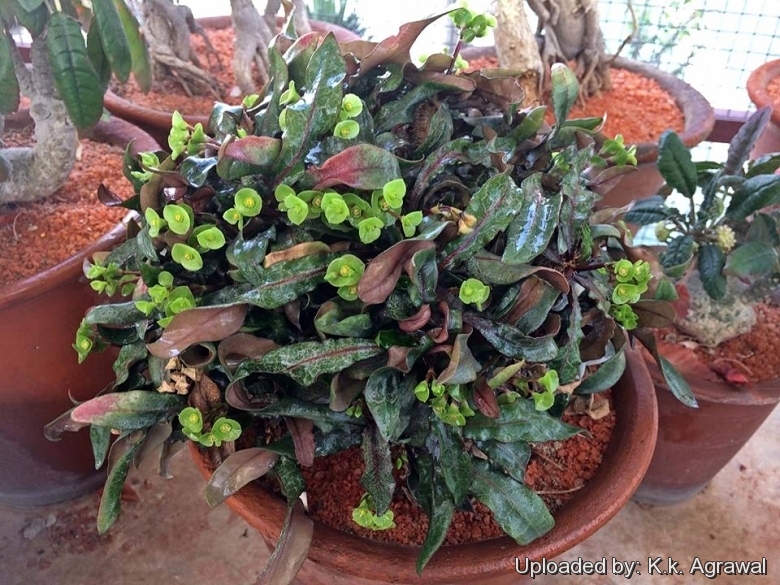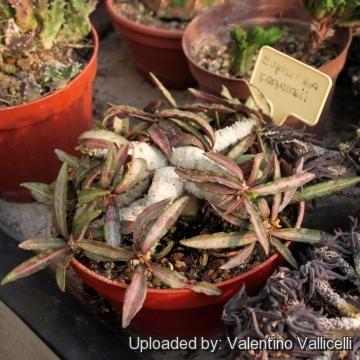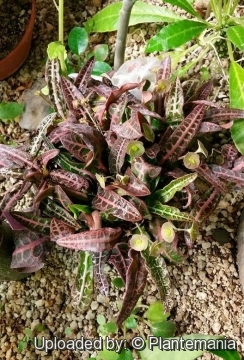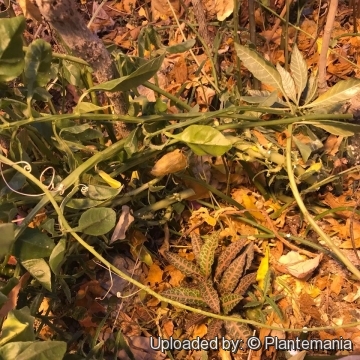




Your support is critical to our success.
- Encyclopedia of SUCCULENTS
- Encyclopedia Index
- Families
- Genera
- Species
- Euphorbiaceae
- Euphorbia
- Caudiciforms
Since 4 Aug 2013

Variable leaf shape, even on the same plant, variable leaf color and pattern. Leaves can be shades of green, almost to black, white to silver, with red veining. Subterranean napiform root, which can be raised for bonsai effect.
Origin and Habitat: Taolanaro (Fort-Dauphin and Andrahomana near Ranopiso), Southern Madagascar.
Altitude: It grows at low elevation up to 50 metres asl.
Habitat: Euphorbia francoisiiSN|25173]]SN|25173]] has a very small extent of occurrence on the sand dunes near the Vinanibe coast, in the open or beneath low bushes.
Synonyms:
- Euphorbia francoisii Leandri
Euphorbia francoisii Leandri
Notul. Syst. (Paris) 12: 161 1946
Accepted name in llifle Database:
Euphorbia francoisii var. crassicaulis Rauh
Euphorbia J. 0: 183-187. ills.. 1997
Synonymy: 2 Accepted name in llifle Database:
Euphorbia francoisii hybrid hort.
Description: Euphorbia francoisii is a very variable caudiciform shrublet up to 15 cm tall. Without question, it is one of the most popular Euphorbias in the Euphorbia ambovombensis group with beautiful leaves coming in a dazzling array of shapes and colours that change with the seasons. If the unique leaf coloration and shape from one plant to the next were not enough the individual leaves on a single plant can vary in color and shape. In its natural habitat it is a seashore plant with underground stolons which does not make any stem growth above ground whatever apart from a rosette, flat on the ground. It is allied to such well-known caudex-forming euphorbia species as Euphorbia decaryi, Euphorbia cap-saintmariensis, Euphorbia cylindriflora.
Roots: Tuberose merging with the stem to form a succulent geophytic caudex (rootstock). The tuberous roots are very decorative and in many plants in cultivation are often raised above the soil. In seed raised plants, the caudex tend to be much larger and solitary (or few branched) while in plants which have been raised from cuttings, the tuberose roots tend to be thinner, and are more branched, eventually producing tangled masses of many fat roots.
Branches: Several, beige, rounded, erect, sprawling or procumbent, 5 - 10 cm long, and 5 mm in diameter slowly enlarging at the bases to reach in time the size and form of a small carrot. The branches sprawl and twists gracefully in a random fashion making each plant a unique living sculpture.
Leaves: Evergreen in rosettes at the end of the branches, very variable both as to form, succulence and colour. Blade oblong, lanceolate or spade shaped (occasionally deltoid or even lyre shaped) 2-8 cm long and 0,3-3 cm wide, leathery, glabrous, smooth, and typically flat in cross section, multicoloured, dark-green, pink, purple, white and variegated. The variegation emerges and radiates throughout the leaf as it matures and changes throughout the year. Margin slightly wavy sometimes of a different colour than the rest of the leaf. Stipules cartilaginous, persistent, up to 4 mm, expanded and divided at the base, whitish.
Inflorescence: 1-2-forked cymes at the branches tips among leaves, on peduncles upto 2 cm long. Cyathia 3 mm in diameter enveloped by large yellowish green to pinkish, cyathophylls (coloured bracts) spreading, rounded, up to 7 x 12 mm wide. Nectar glands yellow. Ovary subsessile
Remark: The uniqueness of each francoisii plant's leaf coloration and branch architecture is is due to the fact that they are hexaploids.
Taxonomic note. Originally published as “françoisi” but corrected in “francoisii” (2006: Art. 60.6 and 60.11; the French “ç” being a diacritic sign is to be corrected).
Subspecies, varieties, forms and cultivars of plants belonging to the Euphorbia francoisii group
 Euphorbia francoisii Leandri: (var. francoisiii) is a very variable caudiciform shrublet up to 15 cm tall with beautiful leaves coming in a dazzling array of shapes and colours that change with the seasons. Distribution: Andrahomana, SW Taolanaro, Madagascar.
Euphorbia francoisii Leandri: (var. francoisiii) is a very variable caudiciform shrublet up to 15 cm tall with beautiful leaves coming in a dazzling array of shapes and colours that change with the seasons. Distribution: Andrahomana, SW Taolanaro, Madagascar. Euphorbia francoisii var. crassicaulis Rauh: has thicker and larger branches up (to 30 cm and 2 cm in diameter); Leaves up to 10 cm long with crisped margins.
Euphorbia francoisii var. crassicaulis Rauh: has thicker and larger branches up (to 30 cm and 2 cm in diameter); Leaves up to 10 cm long with crisped margins.- Euphorbia francoisii f. rubrifolia Rauh: has wine-red leaves and pinkish veins even darker during winter. Seedlings also have red leaves. Distribution: Andrahomana.
Notes: Euphorbia francoisiiSN|25173]]SN|25173]] is extremely variable in leaf shape and colour, and the high degree of variation within the species make it a candidate for selective breeding. Many impassioned succulent growers in Thailand and in other countries devoted them selves to this fascinating plants. There is enough variation to make them the object of careful hybridization, normally reserved for Haworthias. Innumerable beautiful and highly prized varieties are now available in this country and aboard.
Bibliography: Major references and further lectures
1) Urs Eggli “Illustrated Handbook of Succulent Plants: Dicotyledons” Volume 2. Springer, 2002
2) Werner Rauh, Herman Schwartz “Succulent and xerophytic plants of Madagascar” Vol. 2 Strawberry Press, 1998
3) Gordon Rowley “Caudiciform and Pachycaul Succulents: Pachycauls, Bottle-,Barrel-And Elephant-Trees and Their Kin a Collector's Miscellany” Strawberry Press. June 1st 1987
4) Werner Rauh “The Wonderful World of Succulents: Cultivation and Description of Selected Succulent Plants Other Than Cacti” Smithsonian Institution Press, 1984
5) Cactus and Succulent Society of Australia “The Spine” Vol. 11-15 1962
6) Haevermans, T. 2004. "Euphorbia francoisii." In: IUCN 2012. IUCN Red List of Threatened Species. Version 2012.2. <www.iucnredlist.org>. Downloaded on 24 March 2013.
7) Pijaya Vachajitpan "Euphorbia francoisii Cultivars in Thailand" Cactus and Succulent Journal 86(5):237-239. 2014
8) MCNEILL J., BARRIE F. R., BURDET H. M., DEMOULIN V., HAWKSWORTH D. L., MARHOLD K., NICOLSON D. H., PRADO J., SILVA P. C., SKOG J. E., WIERSEMA J. H., & TURLAND N. J. (eds) 2006. "International Code of Botanical Nomenclature (Vienna Code). Adopted by the Seventeenth International Botanical Congress Vienna, Austria, July 2005. Regnum Vegetabile" 146: 1-568.
9) Haevermans T., Rouhan G., Hetterscheid W., Teissier M., Belarbi K., Aubriot X. & Labat J.-N "Chaos revisited: Nomenclature and typification of the Malagasy endemic Euphorbia subgenus Lacanthis (Raf.) M.G.Gilbert" Adansonia 31(2):279-299 · December 2009

Euphorbia francoisii Photo by: Valentino Vallicelli

Euphorbia francoisii Photo by: © Plantemania

Euphorbia francoisii in the leaves litter, virgin forest of Madagascar. Photo by: © Plantemania
The gallery now contains thousands of pictures, however it is possible to do even more. We are, of course, seeking photos of species not yet shown in the gallery but not only that, we are also looking for better pictures than those already present. Read More...
Cultivation and Propagation: Euphorbia francoisiiSN|25173]]SN|25173]] is a particular favourite of caudiciform plant enthusiasts. Cultivation of this plant is the same as that for the other tuberous varieties of Euphorbia from tropical areas (Madagascar, and central Africa) , but it is not the easiest of all caudiciform Euphorbias. It is particularly prone to rot if left cold and damp while dormant. As the plant ages, it develops a nice caudex, and can be used to make extremely attractive bonsai.
Growth rate: It is a slow growing species and tubers take many years to enlarge.
Caudex exposure: The remarkable tuberous rootstock (caudex) is usually raised above the soil line so that this can be seen and more readily appreciated. The plants raised from cuttings produce a bunch of tangled tuberose roots, while seed raised plants produce a more rounded tuber with age. For best results the tuber must be exposed only when plans become mature enough, usually after several years (8-12 or more years) of underground growth, as the exposed caudex will no longer increase in size once it has been lifted above the soil line. In very old plants, the tuber can achieve massive proportions, so keep a plant for many years to grow an unusually large caudex.
Soil and pots: It likes pots with generous drain holes, needs a very airy potting medium which mainly consists of non organic material such us clay, pumice, lava grit, and only a little peat or leaf-mould, seeing that the main trunk is planted with the majority of the roots below the caudex line. It's rare that it will use the upper third of its soil and often this area serves like a mulch or support for the stem.
Fertilization: Need a perfect fertilizer diet in summer. Use preferably a cacti and succulents fertilizer with high potassium content including all micro nutrients and trace elements or slow release fertilizer.
Exposure: This plant has an excellent heat tolerance, and need full sun to light shade exposures, but can tolerate shade. However shade grown plants will tend to produce fewer, and etiolated growth (weak, gangly stems with unusually long internodes, and generally paler green coloration). The colour of this plant is much more marked if grown in full sun. But if it is possible to keep the growth of this species compact, with denser, shorter stems of a more uniform length (rather than looking weedy) such plants can be outright attractive.
Watering: Water regularly during the active growing season. No water should ever be allowed to stand around the roots. Keep almost completely dry in winter. Even though the swollen caudex ensures a long lasting water reserve making it very tolerant of under watering, this euphorbia is difficult, turning immediately to mush when over watered, or watered out of season. Care must be given in watering, keeping them warm and wet while growing, and cooler and dry when dormant.
Hardiness: Tender. Euphorbia francoisiiSN|25173]]SN|25173]] does not require cool temperatures for its growth cycle or flowering as some of the cactus and crassula species do, and it has not an apparent dormancy period but periods where the emergence of new leaves stops and older leaves wither and drop. This spurge can be difficult to get it to look its best without a good amount of heat and sun and so it is only really suited to the tropics (USDA Zones 10-11). Keep the plant cooler in winter, but maintain the light as bright as you can so that any growth which it may produce at this time will not be etiolated. It can be grown outdoors in the summer months to benefit from direct exposure to light, and especially exposure to high summer temperatures. Protection in a warm greenhouse in the middle of the winter will greatly increase the survival rate.
Rot: Rot is only a minor problem with Euphorbias if the plants are watered and “aired” correctly. If they are not, fungicides won't help all that much. It is very unlikely to lose this plant from root rot from excessive water.
Maintenance: Re-pot every two years and trim off the dead 'arms'.
Known hazards: The latex/sap is poisonous and can cause skin rash, itching and general discomfort, and they should be handled with caution, particularly when pruning.
Propagation: The plant can be reproduced by seeds or cuttings. The seed will loose viability in storage, and may not be viable the following year, so the seed should be planted as soon after harvesting as possible. Germination usually occurs within about a week or two. If you remove an offset, remember to let it dry for some days, letting the wound heal (cuttings planted too soon easily rot before they can grow roots). Lay it on the soil and insert the stem end partially into the substrate. Try to keep the cutting somewhat upright so that the roots are able to grow downward. It is better to wash the cut to remove the latex. The newly planted stems take a few weeks to establish, and then start growing. Some plant form a perfectly symmetrical caudex when grown from seed. If a caudex is produced from cutting it is often distorted.
| Your Actions | |
|---|---|
| Back to Euphorbia index | |
| Back to Euphorbiaceae index | |
 |
Back to Succulents Encyclopedia index |
Privacy stantement - Terms and conditions - How to cite - About us - Feedback - Donate



